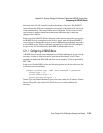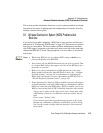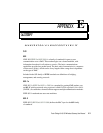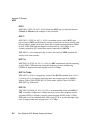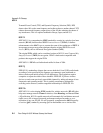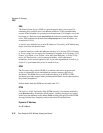Psion Teklogix 9160 G2 Wireless Gateway User Manual E-3
Appendix E: Glossary
802.11d
802.11d
IEEE 802.11d defines standard rules for the operation of IEEE 802.11 wireless
LANs in any country without reconfiguration. PHY requirements such as provides
frequency hopping tables, acceptable channels, and power levels for each country
are provided. Enabling support for IEEE 802.11d on the access point causes the AP
to broadcast which country it is operating in as a part of its beacons. Client stations
then use this information. This is particularly important for AP operation in the
5GHz IEEE 802.11a bands because use of these frequencies varies a great deal from
one country to another.
802.11e
IEEE 802.11e is a developing IEEE standard for MAC enhancements to support
QoS. It provides a mechanism to prioritize traffic within 802.11. It defines allowed
changes in the Arbitration Interframe Space, a minimum and maximum Contention
Window size, and the maximum length (in kµsec) of a burst of data.
IEEE 802.11e is still a draft IEEE standard (most recent version is D5.0, July 2003).
A currently available subset of 802.11e is the Wireless Multimedia Enhancements
(WMM) standard.
802.11f
IEEE 802.11f (IEEE Std. 802.11f-2003) is a standard that defines the inter access
point protocol (IAPP) for access points (wireless hubs) in an extended service set
(ESS). The standard defines how access points communicate the associations and
reassociations of their mobile stations.
802.11g
IEEE 802.11g (IEEE Std. 802.11g-2003) is a higher speed extension (up to 54
Mbps) to the 802.11b PHY, while operating in the 2.4 GHz band. It uses orthogonal
frequency division multiplexing (OFDM). It supports data rates ranging from 1 to
54 Mbps.
802.11h
IEEE 802.11h is a standard used is to resolve the issue of interference which was
prevalent in 802.11a. The two schemes used to minimize interference in 802.11h are



